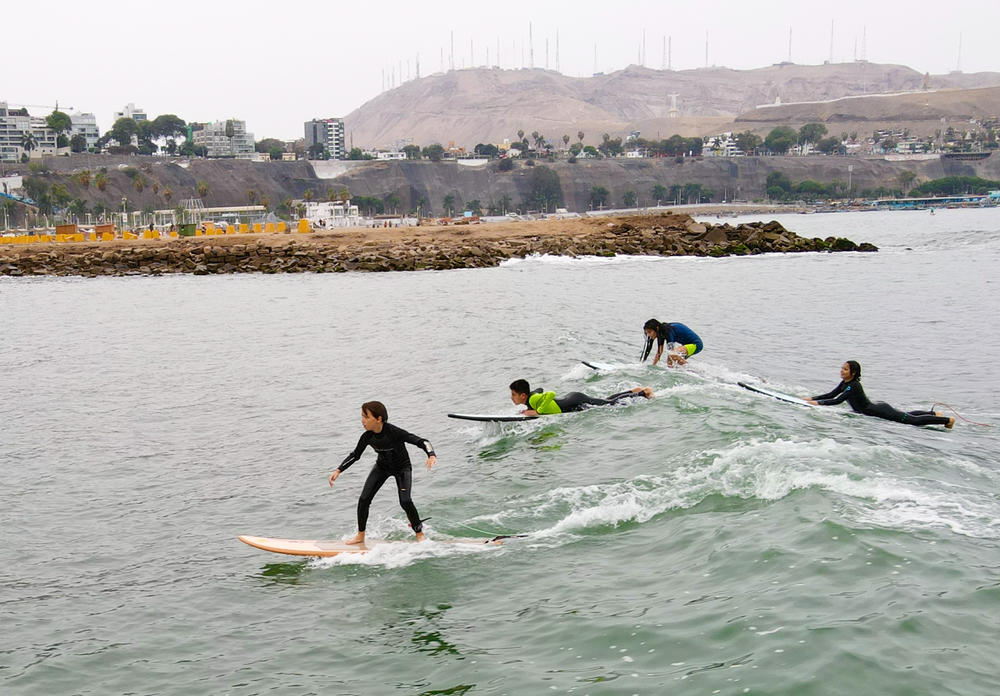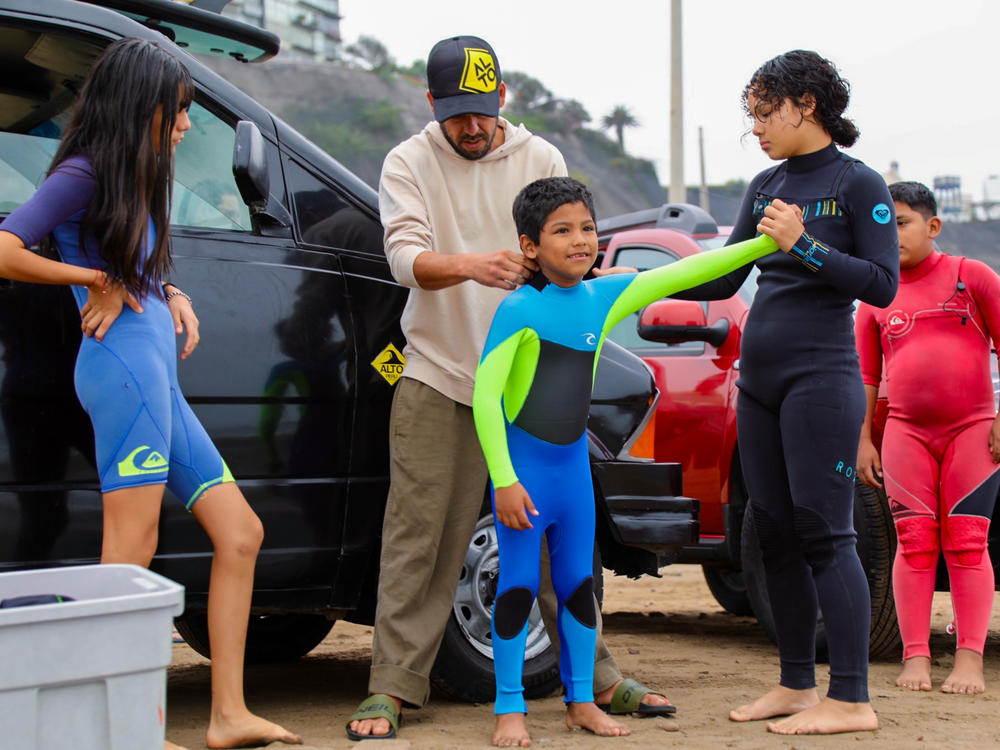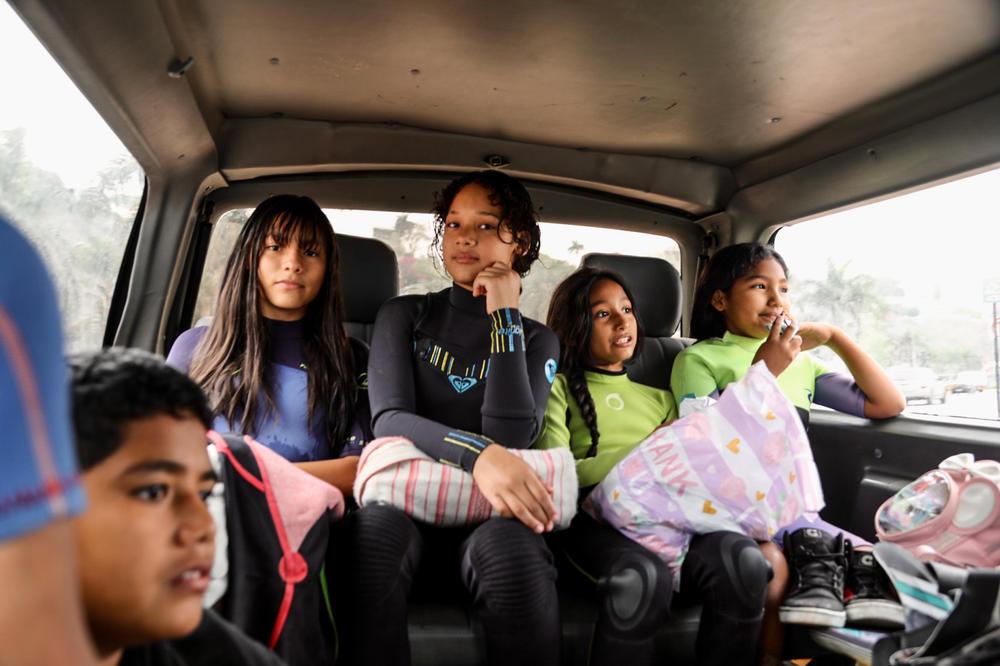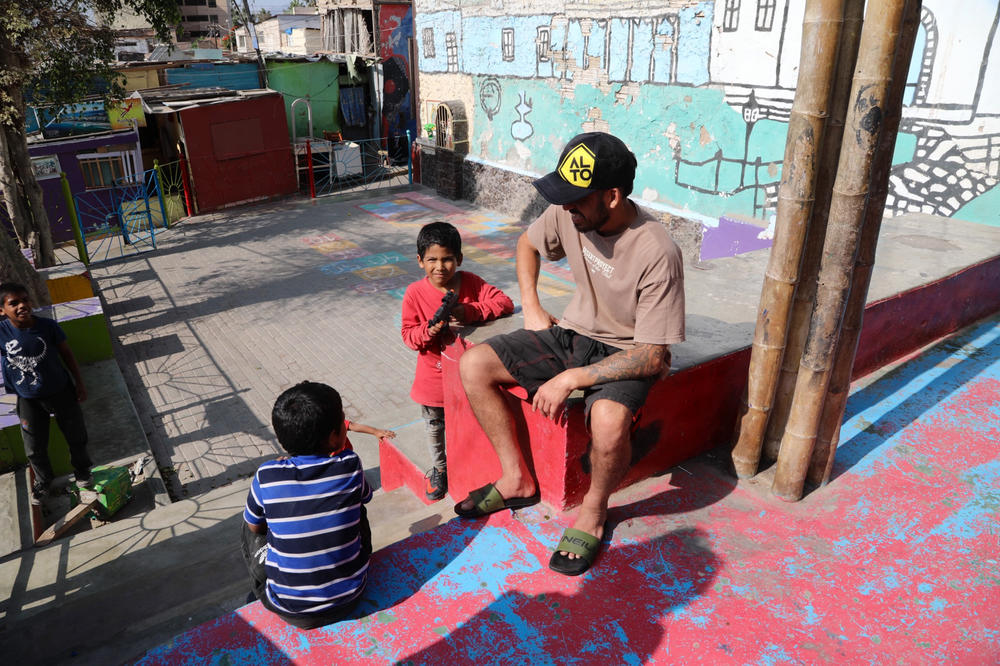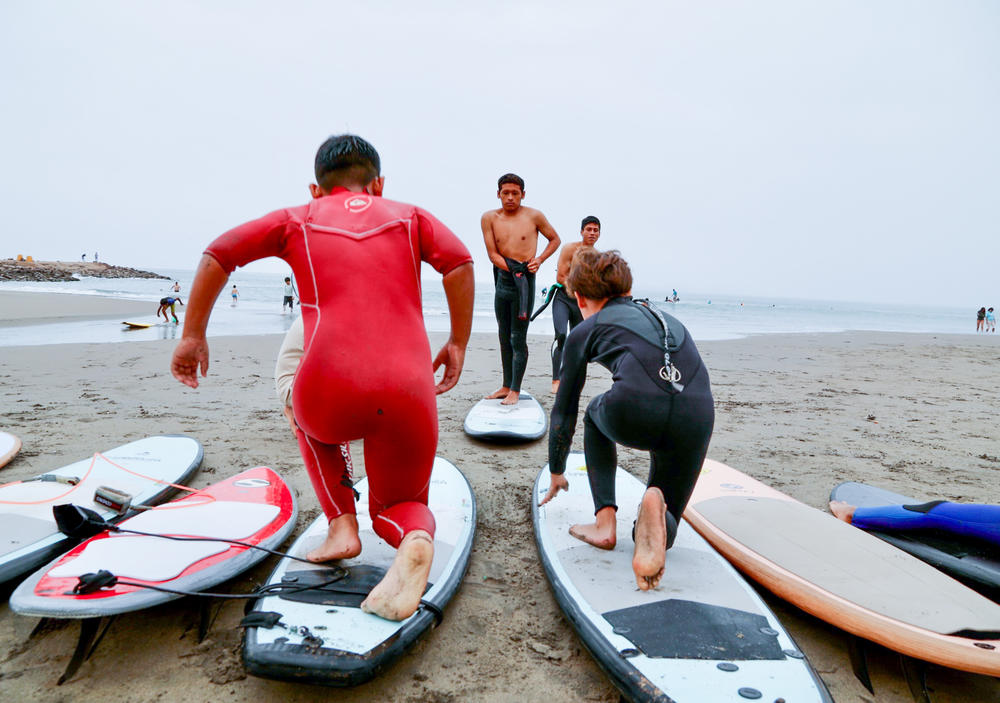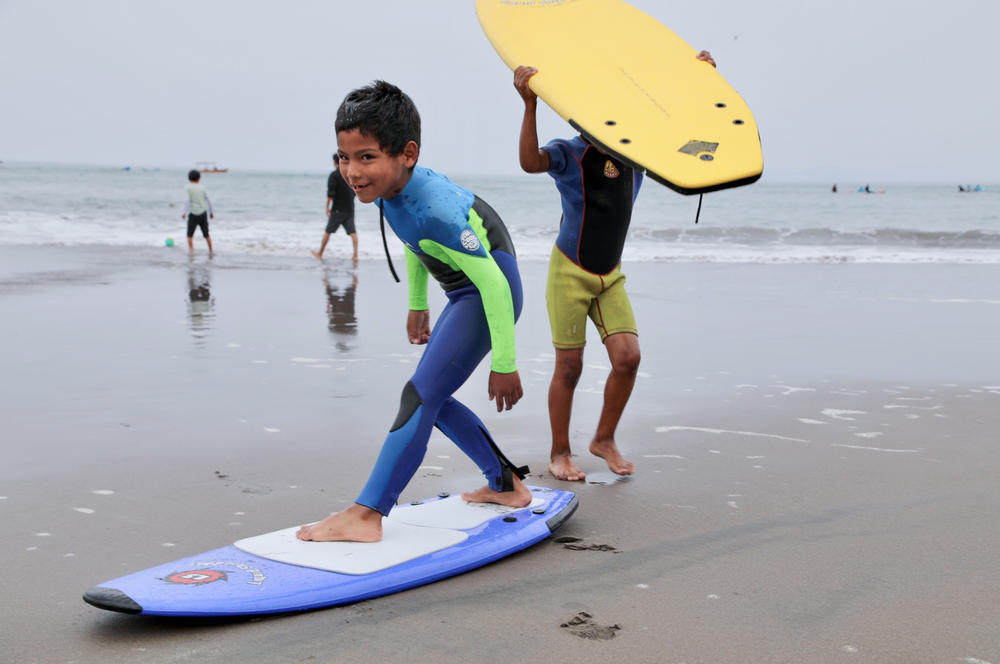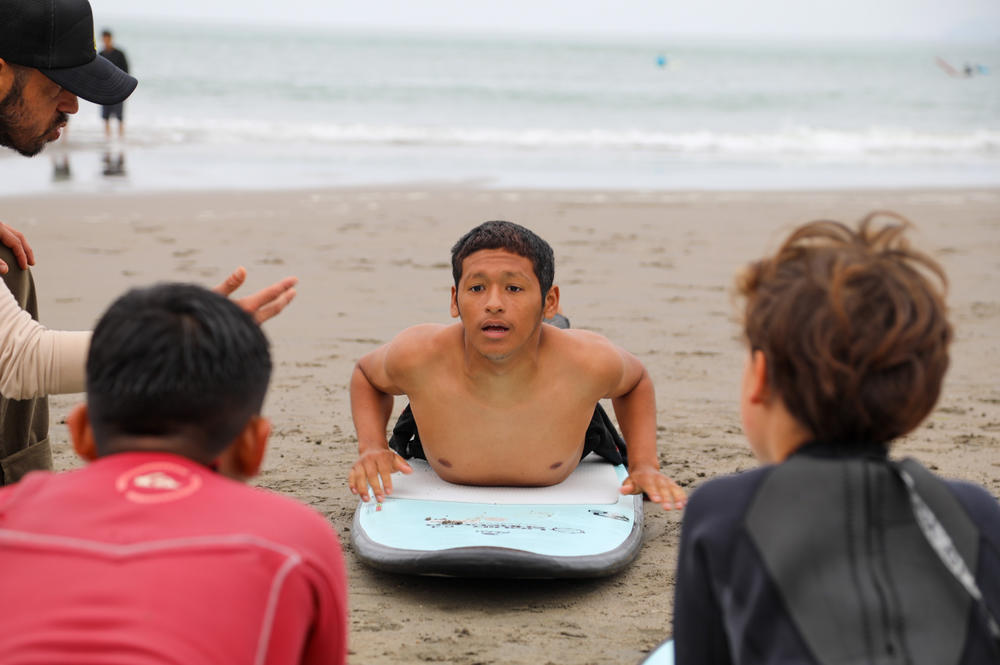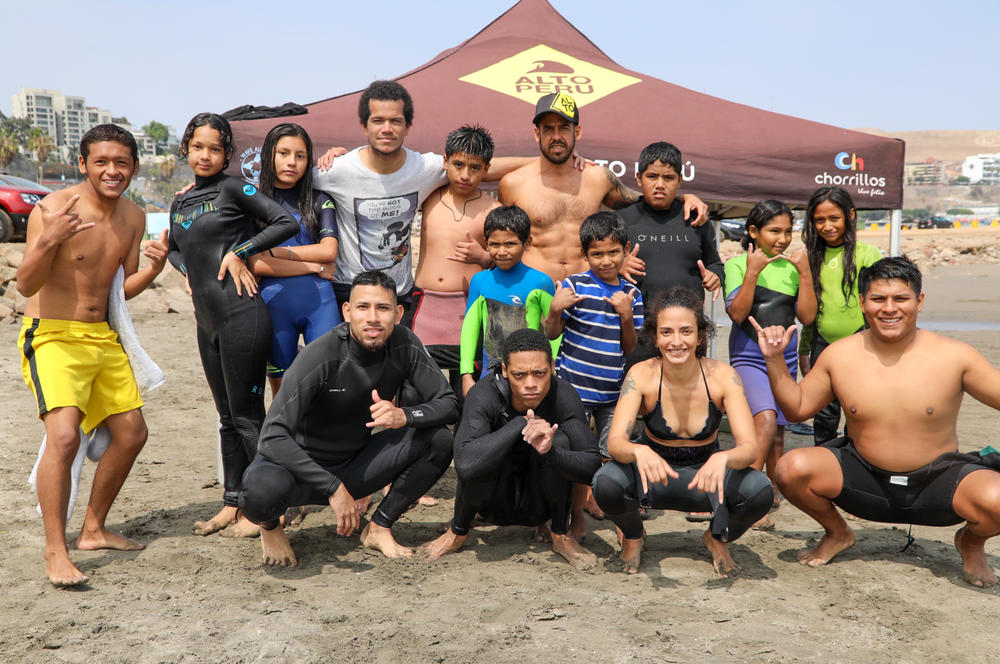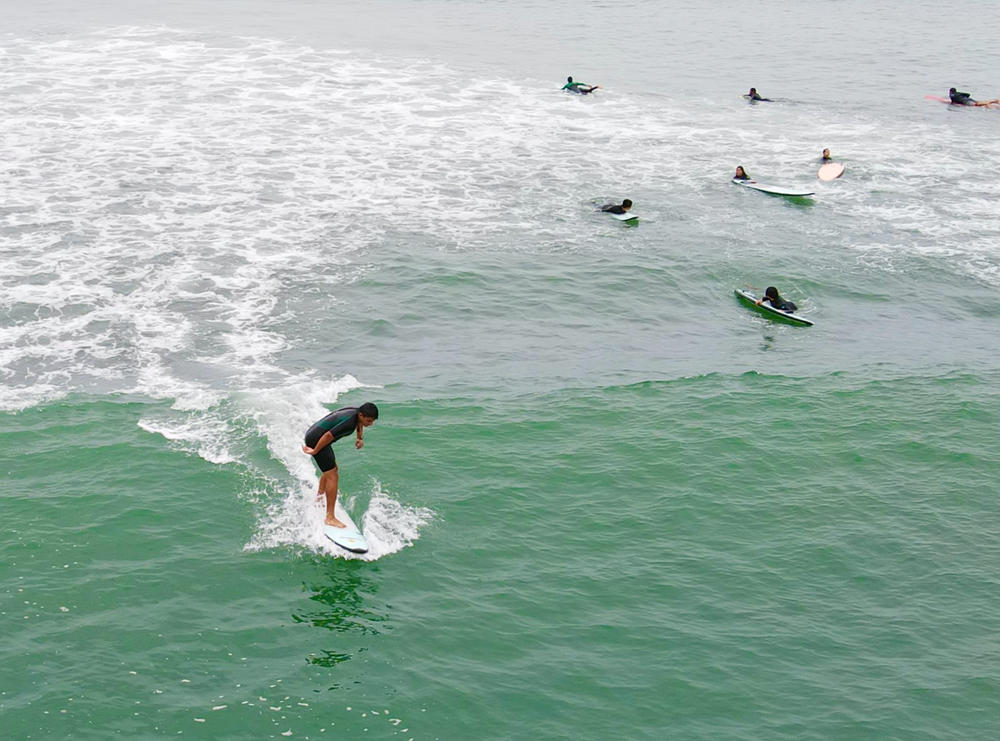Section Branding
Header Content
For these Peruvian kids, surfing isn't just water play
Primary Content
As soon as Boran Bumovich Hignio's bare feet touch the powdery sand of Playa Sombrillas, he breaks into a sprint, spins his arms like a helicopter and lets out a blissful, high-pitched howl: "Vamos aaa surfeeeaaaar! (Let's gooo surrrffffinggg!)"
The 7-year-old, wrapped in a black wetsuit, is followed by a dozen other kids who hop and skip their way into the bracing blue waves of the Pacific Ocean off the coast of Peru's capital, Lima.
"Hey, hey guys, calm down," says Diego Villarán, who's been tasked with looking after the rowdy horde of debutant surfers. "Come over here. You all know that first we need to do our warmups before anything else."
The benefits of catching a wave
This Peruvian surf school is part of a wave of community-based projects around the world that uses a perhaps surprising method to help kids: surf therapy.
The idea is not only about catching waves to tap into the proven mental health benefits of physical exercise. The wider goal is to create a space for young children to express themselves carefree, to help teach them how to process their emotions and to create positive social connections. It's not just a surfer's pipe dream either – studies have shown that surf therapy can foster self-esteem, fight off depression and even help to heal post-traumatic stress disorder.
Lima's surf therapy initiative is run by Alto Peru, a local nonprofit named after the notoriously dangerous, marginalized neighborhood in the south of the city where Villarán – its 41-year-old founder – and all of the trainee surfers come from.
"In this place, we're alone," says Villarán, who founded the project and has trained about 400 local kids over a decade, using funds obtained from local donations and paid surf classes for the public. "We're without support. There's no playgrounds. No good health care. No good education. Violence and drugs are everywhere."
As well as the surfing, Alto Peru is leaning on its hard-earned community trust built up over the years to develop the neighborhood, which is a short but steep walk up from the beach. The nonprofit has painted colorful murals on several walls with the help of kids and a playground has been created at the site of a former trash dump.
Many of the children in the Alto Peru program face challenging circumstances, according to Villarán, who was born and raised in the neighborhood and knows the families. Some parents are addicted to drugs and alcohol, he says. Some girls have told members of the team that they are victims of sexual violence. One of the boys has turned up for lessons with a black eye a couple of times. A psychologist is on the team if needed.
"But we don't ask questions if they don't want to talk," adds Villarán. "This is about creating a different world for them. A place where they aren't afraid."
Surf therapy, which spans projects from Sierra Leone to California and Trinidad, is seen by advocates as a compelling solution to help address mental health issues among young people. Half of all mental health disorders begin before the age of 14 and up to a fifth of adolescents globally experience mental health conditions, according to the World Mental Health Survey Initiative, which conducted face-to-face interviews in 17 countries across Africa, Asia, the Americas and Europe.
How it all got started
Its origins trace back more than a decade ago to South Africa, with the launch of the Cape Town-based nonprofit Waves for Change in 2009.
What began as a weekend project has since exploded into a worldwide movement of 50 programs in over a dozen countries, all using an evidence-based methodology to deal with trauma. Thousands of children, and in some cases, even adults, are taking part.
In South Africa, the programs, which include one session per week for 10 months and "aftercare" support, are held at five beach hubs. In 2022, they supported 2,280 children – referred by local nonprofits – all living within about 6 miles of the hubs.
"In the early days, the focus was more on the kinds of games we did," says founder Tim Conibear. "We wanted to build confidence, create safe spaces where they're not constantly have to process adversity."
They still do that. But over time, Waves for Change has refined its process and built key pillars: creating safe spaces; teaching coping mechanisms; building strong connections with coaches and fellow youth from the community; and helping the kids get access to other social services like education and health care.
Conibear says he didn't realize until later that the sense of belonging kids feel is just as important as the surfing itself. "Instead of relying on activities, we are prioritizing how the coaches act with the kids," he says. "It's about forming healthy attachments with people in the community who care about them."
Kids who were in the program in the past are now supporting the next generations. In 2022, Waves for Change trained and employed 43 former participants as surf therapy coaches – men, women and non-binary people ages 18-25 years who are based in the local communities, speak local languages and understand cultural sensitivities.
"I want to help other kids like me," says Jesus Verano, 28, who began as a trainee with Alto Peru and now several years later has become the head coach. "Surfing, it's a perfect moment. You relax, there's no problems. It's meditation between the waves."
Studying surf therapy
A slew of research has shown how this fine-tuned method is making a splash. A surf therapy evaluation of programs in the U.K. held between 2013 and 2017 found that participants benefited from a "transformation in their lives, shifting from isolation to engagement," according to findings published in the Global Journal of Community Psychology Practice. Research in 2022 by the New School for Social Research New York found that surf therapy in South Africa "improved social connectedness" and "reduced impulsivity" among 233 young surfers in therapy programs. Other research has linked surf therapy to significantly lower post-traumatic stress disorder and depressive symptoms among veterans in the U.S.
"We know physical exercise is good for your mental health, that's an undoubted fact," says Jamie Marshall, a researcher at Edinburgh Napier University who wrote a Ph.D on surf therapy among adolescents in post-conflict Liberia, veterans in Los Angeles and youth at-risk-of or with mental health diagnosis in Australia. "But it doesn't account for the magnitude of improvement we see on the ground. There's so much more to surf therapy."
Going forward, Waves of Change is working to expand its model. For years, it has been teaching other surf organizations its evidence-based surf therapy methodology through a project known as the Wave Alliance. In 2018, two employees from Alto Peru went to South Africa for training. Soon, Waves for Change will make its coaching practice and curriculum available for free.
Marshall argues these "foundational therapeutic structures" promoted by Waves for Change are key to the treatment's effectiveness. "Surfing is just the vehicle," he says. "You need these other structures around it for it to become surf therapy."
But Marshall warns context is crucial: The language used and coping mechanisms taught will vary hugely between different groups. "You wouldn't run the same course for kids in Liberia as you would for veterans in the United States," he says.
Yet the model is already proving transferable. Another organization that received training from Waves for Change is Trinidad & Tobago's Waves for Hope, which combines surfing, group discussion and mentorship to cater to "at-risk youths" in under-served communities across the Caribbean nation. "It has changed my life," says Omarion Butler, 19, who began surfing with Waves for Hope two years ago. "When my parents put me down in the past, it was hard for me to interrogate my feelings. But surfing makes me more confident. It helps me to take five, take time for myself."
It's even being used by a surf instructor in Maui to provide a respite to those who lost their homes in the recent wildfires.
In turn, Alto Peru has now become a beacon of surf therapy for the region as it has trained surf organizations in other Peruvian cities – Share de Wave in Trujillo, Puemape Planet in Pacasmayo and Waves Lobitos in Piura – as well as neighboring countries with Chile's Club TotoDrake and Colombia's Fundacion Buen Punto.
Back in Lima, the midday sun finally burns off the lingering cloud cover as the boys and girls of Alto Peru fight to catch a break, in many senses, through surfing. "It's great to be with your friends in the water," says Joaquin Cuya, a 23-year-old trainee turned trainer, crouching by his orange and white surfboard. "We can forget about everything else. We're free."
Peter Yeung is a freelance journalist who covers climate, global health, migration, human rights, often through a critical, solutions-orientated lens. He has written for the BBC, The New York Times, National Geographic, The Guardian and NPR, among others.
Copyright 2023 NPR. To see more, visit https://www.npr.org.
